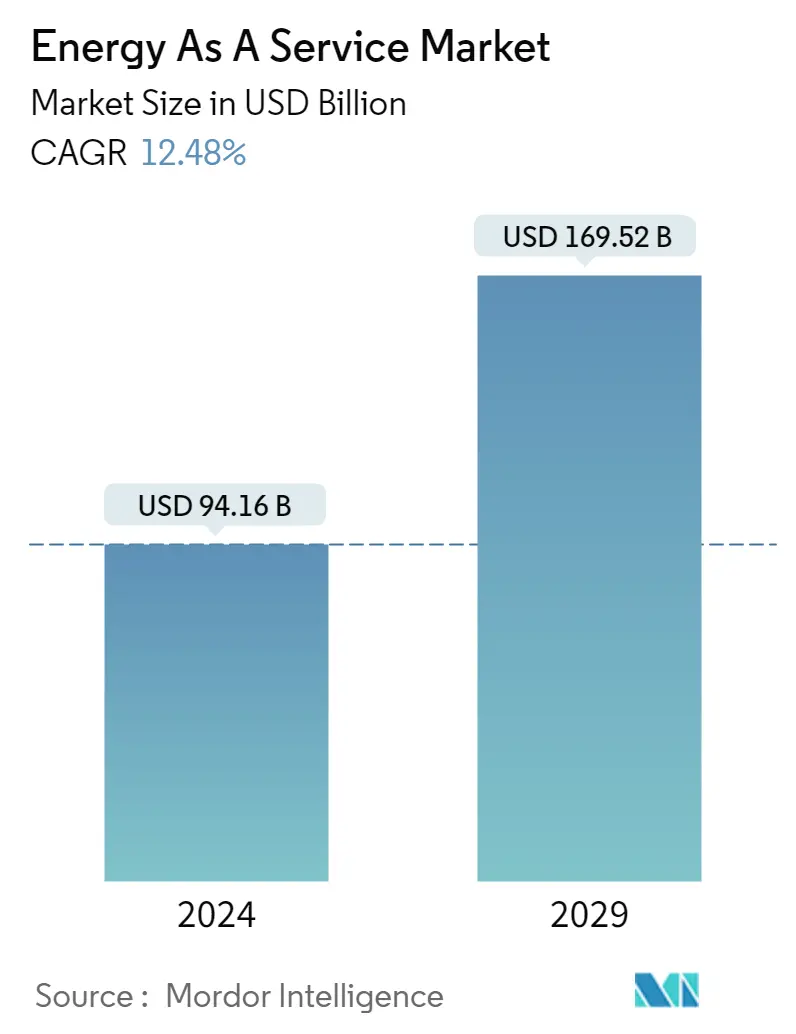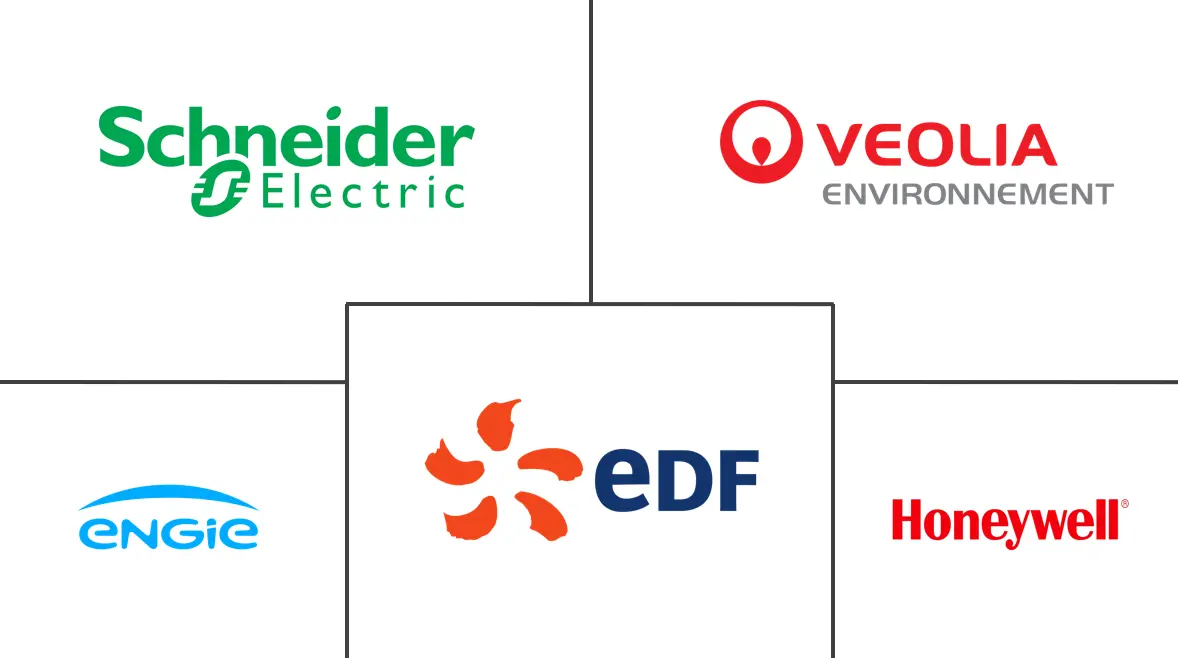Market Size of Energy As A Service Industry

| Study Period | 2020 - 2029 |
| Market Size (2024) | USD 94.16 Billion |
| Market Size (2029) | USD 169.52 Billion |
| CAGR (2024 - 2029) | 12.48 % |
| Fastest Growing Market | Middle East and Africa |
| Largest Market | Europe |
| Market Concentration | High |
Major Players
*Disclaimer: Major Players sorted in no particular order |
Energy as a Service (EaaS) Market Analysis
The Energy As A Service Market size is estimated at USD 94.16 billion in 2024, and is expected to reach USD 169.52 billion by 2029, growing at a CAGR of 12.48% during the forecast period (2024-2029).
- Over the medium term, the increasing adoption of distributed energy generation in commercial and industrial sectors, stringent energy efficiency regulations, and supportive government initiatives are expected to drive the market during the forecast period.
- On the other hand, the lack of awareness in developing economies and high technological costs will likely hinder the market's growth during the forecast period.
- Nevertheless, the Energy as a service concept is still nascent, especially in developing countries. However, in developed countries, the service is on-demand. Developing countries like India, Vietnam, and Indonesia with high energy consumption will likely create ample opportunities for the Energy as a service market during the forecast period.
- North America dominates the market and will likely witness the highest CAGR during the forecast period, with most of the demand coming from countries like the United States and Canada.
Energy as a Service (EaaS) Industry Segmentation
Energy as a Service (EaaS) is a business model where the consumers only pay for energy services without making any initial capital investment. EaaS uses conventional arrangements, including energy supply contracts (ESCs), energy performance contracts (EPCs), and power purchase agreements (PPAs), and employs alternative models that lower or eliminate upfront costs around funding, owning, and operating capital-intensive energy generation and storage systems.
The Energy as a service market is segmented by end-user and geography. By end-user, the market is segmented into commercial and industrial. The report also covers the market size and forecasts for the Energy as a service market across major regions. Each segment's market sizing and forecasts are based on revenue (USD).
| End User | |
| Commercial | |
| Industrial |
| Geography | |||||||
| |||||||
| |||||||
| |||||||
| |||||||
|
Energy As A Service Market Size Summary
The Energy as a Service (EaaS) market is poised for significant growth, driven by the increasing adoption of distributed energy generation and stringent energy efficiency regulations, particularly in commercial and industrial sectors. Government initiatives are further bolstering this trend, although challenges such as lack of awareness in developing economies and high technological costs may impede progress. The concept of EaaS is still emerging in developing countries, while it is well-established in developed regions. Countries with high energy consumption, like India, Vietnam, and Indonesia, present substantial opportunities for market expansion. North America leads the market, with the United States and Canada contributing significantly to its growth, supported by various energy efficiency projects and smart grid investments.
The commercial sector is a major consumer of EaaS, with increasing electricity demand due to rising per capita income and the proliferation of electrical appliances. Energy as a Service models are addressing historical barriers to energy efficiency, such as high capital costs, by offering comprehensive solutions that include the installation of sustainable technologies like solar PV systems. Notable developments in the market include strategic partnerships and investments by key players such as Schneider Electric, Engie, and Honeywell, aimed at enhancing EaaS capabilities and reducing carbon emissions. These efforts, coupled with the adoption of smart metering systems, are expected to drive the market towards a more decentralized and digitalized grid network, particularly in North America.
Energy As A Service Market Size - Table of Contents
-
1. MARKET OVERVIEW
-
1.1 Introduction
-
1.2 Market Size and Demand Forecast in USD million, till 2028
-
1.3 Recent Trends and Developments
-
1.4 Government Policies and Regulations
-
1.5 Market Dynamics
-
1.5.1 Drivers
-
1.5.1.1 Growing Demand for Energy As A Service
-
1.5.1.2 Increasing Adoption of Distributed Energy Generation in Commercial and Industrial Sectors
-
-
1.5.2 Restraints
-
1.5.2.1 Lack of Awareness in Developing Economies and High Technological Costs
-
-
-
1.6 Supply Chain Analysis
-
1.7 Porter's Five Forces Analysis
-
1.7.1 Bargaining Power of Suppliers
-
1.7.2 Bargaining Power of Consumers
-
1.7.3 Threat of New Entrants
-
1.7.4 Threat of Substitute Products and Services
-
1.7.5 Intensity of Competitive Rivalry
-
-
-
2. MARKET SEGMENTATION
-
2.1 End User
-
2.1.1 Commercial
-
2.1.2 Industrial
-
-
2.2 Geography
-
2.2.1 North America
-
2.2.1.1 United States
-
2.2.1.2 Canada
-
2.2.1.3 Rest of North America
-
-
2.2.2 Europe
-
2.2.2.1 Germany
-
2.2.2.2 France
-
2.2.2.3 United Kingdom
-
2.2.2.4 Rest of Europe
-
-
2.2.3 Asia-Pacific
-
2.2.3.1 China
-
2.2.3.2 India
-
2.2.3.3 Japan
-
2.2.3.4 South Korea
-
2.2.3.5 Rest of Asia-Pacific
-
-
2.2.4 South America
-
2.2.4.1 Brazil
-
2.2.4.2 Argentina
-
2.2.4.3 Rest of South America
-
-
2.2.5 Middle-East and Africa
-
2.2.5.1 Saudi Arabia
-
2.2.5.2 United Arab Emirates
-
2.2.5.3 South Africa
-
2.2.5.4 Rest of Middle-East and Africa
-
-
-
Energy As A Service Market Size FAQs
How big is the Energy as a Service Market?
The Energy as a Service Market size is expected to reach USD 94.16 billion in 2024 and grow at a CAGR of 12.48% to reach USD 169.52 billion by 2029.
What is the current Energy as a Service Market size?
In 2024, the Energy as a Service Market size is expected to reach USD 94.16 billion.

